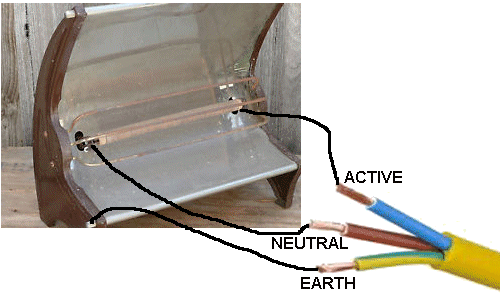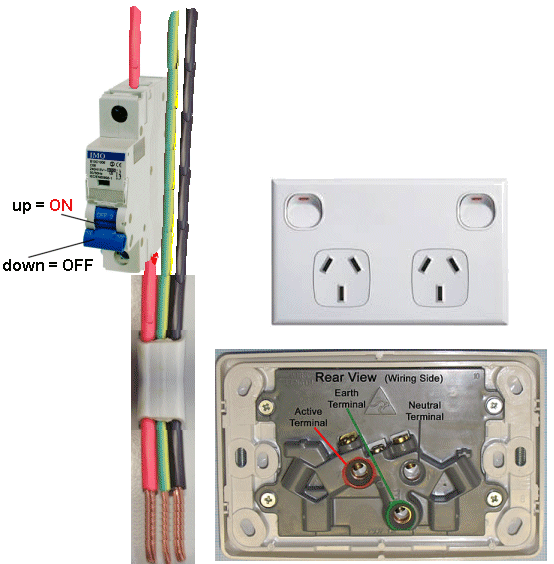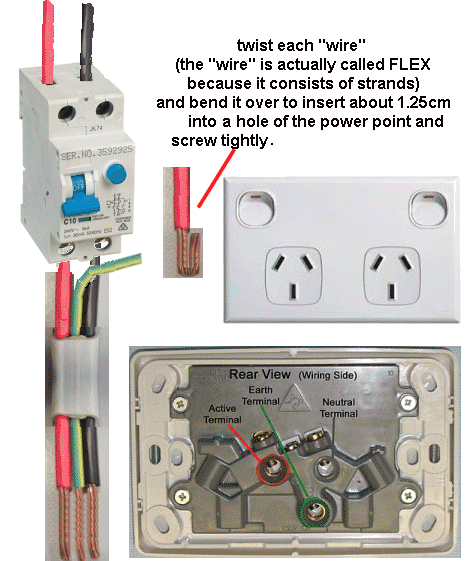Table Of Contents
Index
We still call the box of switches THE FUSE BOX, even though all new installations require CIRCUIT BREAKERS and not “fuses” to be installed.
Circuit Breakers are a vast improvement over the old-fashioned “fuse.”
A FUSE is a piece of fairly thin wire that gets hot when a high current flows and it glows red and burns out.
Fuses can be replaced with thicker wire, and even NAILS to prevent the circuit failing and this is VERY DANGEROUS.
A circuit breaker prevents anyone tampering with the circuit and it will “TRIP” when the specified current flows and it will also trip very quickly when a short-circuit is detected.
This action prevents arcing and sparking at the location of the “short” and minimises the possibility of a fire being produced.
But the biggest advantage of a circuit breaker is its ability to detect when a leakage occurs on any of the “runs.” A RUN is length of cable with numerous light fittings or power points.
THE AC MAINS
Firstly you have to understand what the AC MAINS is.
The AC Mains is a voltage that rises and falls at a rate of 50 times or 60 times per second.
That’s why we call it an OSCILLATING VOLTAGE.
However the term associated with the “MAINS” is AC MAINS, and this refers to ALTERNATING CURRENT.
Where do the letters AC come from ?
This term goes back to the fight between Edison and Tesla, where Tesla produced the far-superior ALTERNATING VOLTAGE whereas Edison produce DIRECT CURRENT distribution. He had to build generating stations every few miles as the voltage on the POWER LINES dropped quite considerably after a few miles and those at the end of the line had very dim lights.
With AC, the distribution could be done with transformers and this extended the distribution to every part of the country.
The tern ALTERNATING CURRENT was used to differentiate from Edison’s DIRECT CURRENT distribution.
That’s why we call the mains ALTERNATING CURRENT or AC or AC MAINS.The ”MAINS” is a voltage of either 120v AC or 240v AC.
The Mains is a very dangerous voltage to deal with as the 120v AC is really a voltage that rises to 180v and then drops to minus 180v at the rate of 60 times per second.
The 240v is really a voltage of 345v and then a voltage of minus 345v, rising and falling at a rate of 50 times per second.
Your body can only handle 60v to 80v and anything above that can cause instant death.
Electricity must pass through your body to earth or a pipe or another wire to produce “electrocution.”
- You cannot get a shock by touching the NEUTRAL wire.
- You cannot get a shock by touching the EARTH wire.
- You cannot get a shock when touching the ACTIVE wire. You must touch the ACTIVE and NEUTRAL or ACTIVE and EARTH.
Here is graphical representation of the voltage appearing on the active wire. The voltage on the NEUTRAL wire is not rising or falling. It is a constant zero volts.

The voltage on the ACTIVE rises to 340v then falls 340v below “ground” 50 times per second and this will produce a CURRENT FLOW through your body that will kill you very quickly.
You get just as big a shock at +340v as -340v.
The action of the voltage rising and falling tends to “throw you off” and some people have been thrown across a room after touching a “live” toaster or jug or kettle.
The EARTH
All “Mains” sockets (power points - called GPO’s - General Purpose Outlets) consist of an ACTIVE, NEUTRAL and EARTH. This is called a 3-pin system with a 3-pin plug.
The most important connection is the EARTH because it protects you from getting a “shock.”
It is important to understand the Active and Neutral carry the “electricity” (called the CURRENT) and the earth is GENERATED by driving a spike into the ground at the front of the premises.
The Active and Neutral enter a property via either overhead or underground via two separate wires (cables) or a screened cable with the ACTIVE in the middle and the NEUTRAL wound around the outside (overhead ONLY).
These two wires go to a transformer on a lamp-post or in a sub-station where the 240v is produced by a STEP-DOWN TRANSFORMER.
At the meter-box, these two wires become ACTIVE and NEUTRAL.
The third wire, called EARTH (green/yellow) is generated by driving a spike into the ground.
We take this lead to the earth pin of all the outlets.
This wire is connected to the frame of all appliances.
The next concept is to understand how the EARTH works.
HOW THE “EARTH” WORKS
Some appliance are DOUBLE INSULATED an do not have an earth lead. We are not talking about these appliances.
We explained above, you cannot get a shock by touching the NEUTRAL wire and you cannot get a shock when touching the ACTIVE wire. You must touch the ACTIVE and NEUTRAL or ACTIVE and EARTH to get a shock.
This is how the EARTH LEAD works:
We have a radiator connected to the mains with the NEUTRAL connected to the left end of the radiator bar, the ACTIVE connected to the right end of the bar and the EARTH connected to the frame of the radiator.

The diagram shows how the wires are connected at the back of the radiator.
This is a DEMONSTRATION DIAGRAM
The wiring is all internal, we have shown where the wires are connected at the back of the radiator.
The radiator is connected correctly and is perfectly safe.
Suppose the left-end of the heating rod touches the frame of the radiator.
Nothing will happen because the NEUTRAL is at the same potential as the EARTH.
But suppose the right-end of the heating rod touches the frame of the radiator. This will cause a SHORT-CIRCUIT and the fuse will blow or the circuit breaker will “trip.”
Now remove the earth wire.
If the left-end of the heating rod touches the frame and if you pick up the radiator and touch the sink in the kitchen, nothing will happen because the NEUTRAL and EARTH are at the same zero potential.
But suppose the right-end of the rod touches the frame and you pick up the radiator and touch the kitchen sink.
You will be instantly electrified.
So, what has the “EARTH” DONE?
It has provided a feature of safety.
It has It has prevented the frame of the radiator becoming LIVE.
HOW TO WIRE A FUSE or CIRCUIT BREAKER
Now we need to know how to wire a CIRCUIT.
A CIRCUIT consists of the MAINS entering a property, passing through a fuse or CIRCUIT BREAKER and emerging at a POWER POINT.
A CIRCUIT BREAKER is connected into the ACTIVE wire - also called the LIVE or LINE.
Household wiring is done with POWER CABLE - commonly called 10-amp POWER or TWIN AND EARTH.
The cable is prepared by stripping and baring the copper wires for 2.5cm. If the cable is fitted into a power point, the wires should be twisted and bent over and inserted so none of the copper is visible when the screw is tighten fairly tight.

The circuit breaker shown above ONLY detects CURRENT OVERLOAD.
The circuit breaker in the diagram below does two things:
- It detects overload AND
- It detects “leakage” of 30mA.
What is RCD?
RCD stands for Residual Current Detector or Device
It is also known as a residual-current circuit breaker (RCCB), Ground Fault Circuit Interrupter (GFCI), Ground Fault Interrupter (GFI) or an Appliance Leakage Current Interrupter (ALCI).
They are all the same thing and consist of an electric device that detects when the current flowing through the ACTIVE lead is 30mA more than the current flowing through the NEUTRAL.
This means some of the current (30mA or more) is is passing down the ACTIVE conductor (wire) but some of it is LEAKING to EARTH via wet conditions, a human body or a faulty appliance and all of the current is not returning via the NEUTRAL lead.

RCD CIRCUIT BREAKER CONNECTED TO A POWER POINT
In the diagram above we have a CIRCUIT BREAKER with leakage current detector RCD. This type of circuit breaker has a TEST BUTTON. The test button is connected to an internal resistor that draws 30mA and trips the breaker.
You do not have to know the internal workings of the detector, but you must know how to connect it to a circuit.
Both the ACTIVE and NEUTRAL of a circuit must pass through the circuit breaker for the imbalance to be detected.
You can push the TEST BUTTON at any time to prove the leakage detection is working.
The lever will trip from an UP position to a DOWN position.
To reset some of the circuit breakers, you need to push the lever DOWN HARD and then push it UP. It you don’t do this, the lever will simply fall down and the breaker will not be reset.
Quick Links
Legal Stuff
Social Media


